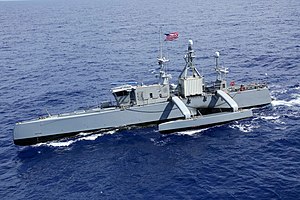
A littoral combat ship (LCS) is either of two classes of relatively small surface vessels designed for operations near shore by the United States Navy. It was "envisioned to be a networked, agile, stealthy surface combatant capable of defeating anti-access and asymmetric threats in the littorals", although their ability to perform these missions in practice has been called into question.

A survey vessel is any type of ship or boat that is used for underwater surveys, usually to collect data for mapping or planning underwater construction or mineral extraction. It is a type of research vessel, and may be designed for the purpose, modified for the purpose or temporarily put into the service as a vessel of opportunity, and may be crewed, remotely operated, or autonomous. The size and equipment vary to suit the task and availability.

An autonomous underwater vehicle (AUV) is a robot that travels underwater without requiring continuous input from an operator. AUVs constitute part of a larger group of undersea systems known as unmanned underwater vehicles, a classification that includes non-autonomous remotely operated underwater vehicles (ROVs) – controlled and powered from the surface by an operator/pilot via an umbilical or using remote control. In military applications an AUV is more often referred to as an unmanned undersea vehicle (UUV). Underwater gliders are a subclass of AUVs.

The Protector unmanned surface vehicle (USV) was developed by the Israeli Rafael Advanced Defense Systems in response to emerging terrorist threats against maritime assets such as the USS Cole bombing, and is the first operational combat USV in service. It is fitted with a Mini Typhoon Weapon Station. In 2005, it was deployed by the Singapore Navy to support coalition forces in the Persian Gulf, and was later deployed for anti-piracy duties in the Gulf of Aden. In 2012, Rafael announced that they were building a larger version of the Protector, that would have a greater range, and be equipped with a wider range of weaponry.

USS Independence (LCS-2) is the lead ship of the Independence-class of littoral combat ships. She is the sixth ship of the United States Navy to be named for the concept of independence. The design was produced by the General Dynamics consortium for the Navy's LCS program, and competes with the Lockheed Martin designed Freedom variant.

An unmanned surface vehicle, unmanned surface vessel or uncrewed surface vessel (USV), colloqually called a drone boat, drone ship or sea drone, is a boat or ship that operates on the surface of the water without a crew. USVs operate with various levels of autonomy, from remote control to fully autonomous surface vehicles (ASV).

The Independence class is a class of littoral combat ships built for the United States Navy.

USS Coronado (LCS-4) is an Independence-class littoral combat ship. She is the third ship of the United States Navy to be named after Coronado, California.

The ASW Continuous Trail Unmanned Vessel (ACTUV) is a DARPA funded project launched in early 2010 to develop an anti-submarine drone. ASW is an acronym for Anti-Submarine Warfare. In January 2018 after successful sea trials it was announced that the "Sea Hunter" prototype has transitioned from DARPA to the Office of Naval Research for further development.

The AGM-158C LRASM is a stealth air launch anti-ship cruise missile developed for the United States Air Force and United States Navy by the Defense Advanced Research Projects Agency (DARPA). Derived from the AGM-158B JASSM-ER, the LRASM was intended to pioneer more sophisticated autonomous targeting capabilities than the U.S. Navy's current Harpoon anti-ship missile, which has been in service since 1977.
Liquid Robotics is an American marine robotics corporation that designs, manufactures and sells the Wave Glider, a wave and solar powered unmanned surface vehicle (USV). The Wave Glider harvests energy from ocean waves for propulsion. With this energy source, Wave Gliders can spend many months at a time at sea, collecting and transmitting ocean data.

The Fleet-class unmanned surface vessel, also called the Common Unmanned Surface Vessel (CUSV) and later the Mine Countermeasures Unmanned Surface Vehicle, is an unmanned surface vessel designed for the United States Navy to be deployed from Freedom and Independence-class littoral combat ships and intended to conduct mine and anti-submarine warfare missions. As of 2012 four units of the class have been built; the first was delivered to the U.S. Navy in 2008.

North Sea Boats is an international boat-building company specialized in building craft for military, law enforcement, SAR, commercial, and high-performance applications. The company has a presence in Sweden, Singapore, and Indonesia, with its headquarters located at Banyuwangi, East Java, Indonesia. North Sea Boats was founded in 2003 by John and Lizza Lundin as a trading name for PT Lundin Industry Invest.
Seaborne targets are vessels or floating structures that are shot at for practice by naval or air forces. They may be remotely controlled and mobile, or towed behind other craft, or just set adrift in the sea.

The Future Multi Purpose Trimaran concept is a concept design of a future naval ship for the Japan Maritime Self-Defense Force.
NOMARS is a concept for a range of ships and smaller watercraft operating as unmanned surface vessels for the US Department of Defense, developed by the United States's Defense Advanced Research Projects Agency (DARPA).
The JARI USV is an uncrewed surface vehicle developed by the China Shipbuilding Industry Corporation (CSIC), specifically between its No. 716 Research Institute, the Jiangsu Automation Research Institute (JARI), and No. 702 Research Institute, China Ship Scientific Research Centre (CSRRC). The uncrewed warship is designed for potential use for the People's Liberation Army Navy and export customers.

Ghost Fleet Overlord is a fleet of test unmanned surface vehicles operated by the U.S. Navy.
Chinese Sea Hunter is a very little known technical research ship in the People’s Republic of China (PRC), but it is not known if it an official Chinese government-funded program such as from the People's Liberation Army Navy (PLAN), or a private venture.














